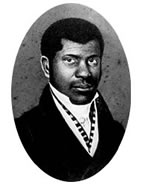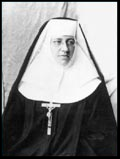Spotlight Archive
The process for canonization of military chaplain Vincent Capodanno, MM, was formally initiated in May. If the Maryknoller completes the lengthy and difficult process, he will join a growing list of men and women from the United States officially honored by the Church as saints.
In Catholic theology, all people are potentially saints by God's grace, and all those who have completed their earthly sojourn and enjoy the Beatific Vision merit the title. But the Church recognizes in a special way particular men and women (and boys and girls) who have exhibited holiness in life to an exemplary degree. Recognition as saints happened in various ways throughout the history of Christianity, but in recent centuries an elaborate canonization process has developed and has become the norm. (Though even this rigorous process can be altered in certain ways in extraordinary cases by the pope, as has occurred for the causes of John Paul II and Mother Teresa of Calcutta.)
Those individuals whose causes for sainthood have gained initial Vatican approval are known as "Servants of God." After extensive investigation and the gathering of personal testimony, if a person's case is judged to have merit, he or she receives the appellation "Venerable." The last stage before canonization (sainthood) is beatification, carrying with it the title "Blessed."
 The earliest saints associated with America were, of course, not Americans. They were the missionaries who carried the faith to the New World—and often died as martyrs. A group of martyr saints were the Jesuit Isaac Jogues and his companions, including René Goupil, who were killed by the Iroquois near the Canadian border in New York. In the same spot (now memorialized by the Shrine of Our Lady of the Martyrs), Native American Blessed Kateri Tekakwitha was born. The "Lily of the Mohawk" provided in her brief life a model of true conversion and sanctity. [Update: Kateri was canonized October 21, 2012.]
The earliest saints associated with America were, of course, not Americans. They were the missionaries who carried the faith to the New World—and often died as martyrs. A group of martyr saints were the Jesuit Isaac Jogues and his companions, including René Goupil, who were killed by the Iroquois near the Canadian border in New York. In the same spot (now memorialized by the Shrine of Our Lady of the Martyrs), Native American Blessed Kateri Tekakwitha was born. The "Lily of the Mohawk" provided in her brief life a model of true conversion and sanctity. [Update: Kateri was canonized October 21, 2012.]
Though he did not die a martyr, Franciscan Blessed Junípero Serra exhibited as much courage and dedication in his mission on the west coast as his Jesuit counterparts had in the east. The founder of the California mission system (and many of its missions), Serra is honored as one of that state's representatives in the National Statuary Hall in the U.S. Capitol.
Ten years before Fray Serra passed away at Mission San Carlos Borromeo, the first saint born in the American colonies entered the world at New York City. Elizabeth Ann Seton's impact on Catholicism in the new nation was immense. She founded one of the country's foremost educational and charitable religious congregations, the Sisters of Charity. Her legacy is preserved at her shrine in Emmitsburg, Maryland.
Meanwhile, a Haitian immigrant practiced his faith devoutly while dressing the hair of the elite of New York society. Venerable Pierre Toussaint worshiped at historic St. Peter Church in Manhattan. Venerable Félix Varela, in exile from Cuba, also worked in New York—as a priest—as well as with Spanish-speaking Catholics in Florida. Two religious superiors from France made important foundations in the American heartland. Saint Philippine Rose Duchesne founded the Society of the Sacred Heart, a congregation of sisters who worked in education. Her sisters were active especially in the lower midwest; their first house was in St. Charles, Missouri. Blessed Theodore Guerin and her Sisters of Providence established St. Mary-of-the-Woods Academy and other charitable institutions in Indiana. [Update: Mother Theodore Guerin was canonized by Pope Benedict XVI on October 15, 2006. She is now a saint.]
Venerable Pierre Toussaint worshiped at historic St. Peter Church in Manhattan. Venerable Félix Varela, in exile from Cuba, also worked in New York—as a priest—as well as with Spanish-speaking Catholics in Florida. Two religious superiors from France made important foundations in the American heartland. Saint Philippine Rose Duchesne founded the Society of the Sacred Heart, a congregation of sisters who worked in education. Her sisters were active especially in the lower midwest; their first house was in St. Charles, Missouri. Blessed Theodore Guerin and her Sisters of Providence established St. Mary-of-the-Woods Academy and other charitable institutions in Indiana. [Update: Mother Theodore Guerin was canonized by Pope Benedict XVI on October 15, 2006. She is now a saint.]
As Catholic immigration increased in the mid-1800s, holy men and women appeared to serve the immigrant community. Bishop John Nepomucene Neumann, a Bohemian by birth, displayed amazing institution-building prowess as well as personal dedication in the diocese of Philadelphia. Mother Frances Xavier Cabrini, shuttling between Italy and the United States, served the needs of fellow Italians making new lives in the New World. Another Italian, Venerable Mary Bentivoglio, established the contemplative Poor Clare sisters in America. Redemptorist Father Francis Seelos, who was beatified in 2000, concentrated mainly on daily parish duties. He gave his life in ministry to yellow fever victims in New Orleans.
Even as the United States developed into a military and economic powerhouse, devout Catholics did not ignore marginalized groups who had failed to realize the promise of American life. Venerable Michael McGivney of Connecticut founded what would become the world's largest Catholic fraternal organization—and one of the nation's largest philanthropic enterprises—the Knights of Columbus. Blessed Damien of Molokai, born in Belgium, dedicated his life to the care of souls in Hawaii's leper colony. [Update: St. Damien was canonized October 11, 2009.] Blessed Marianne Cope, a Franciscan superior from Syracuse, New York, succeeded Damien there a few years later. [Update: Cope was canonized October 21, 2012.] Another upstate New Yorker, Venerable Nelson Baker, managed Our Lady of Victory Institutions in Buffalo, which served countless orphans and others in need. Saint Katharine Drexel, heiress to a  fortune, became Philadelphia's second saint by supplying opportunity to black and Native Americans. Foundress of the Sisters of the Blessed Sacrament, Drexel's wealth and energy alike were spent in the cause.
fortune, became Philadelphia's second saint by supplying opportunity to black and Native Americans. Foundress of the Sisters of the Blessed Sacrament, Drexel's wealth and energy alike were spent in the cause.
In Detroit in the early twentieth century, Venerable Solanus Casey lived humbly as a doorman for his Franciscan brothers. A short time later, another venerable ascended to the height of ecclesiastical stature: Terence Cooke was cardinal archbishop of New York. There were saints, too, in the later twentieth century. Venerable Walter Ciszek braved the KGB and and the gulag during his mission work in Russia. Servant of God Emil Kapaun, an Army chaplain, died a prisoner of war in Korea in 1951. Venerable Patrick Peyton traveled the world over, promoting the rosary and devotion to Mary. Blessed Carlos Rodriguez never left his native Puerto Rico, but shared his faith enthusiastically with students and teachers in the territory's schools and colleges.
The backgrounds of the American saints have mirrored the contours of the country's history: from Spanish and French missionaries in the colonial period, to the Early Republic-era convert Mother Seton, to the immigrant saints Neumann and Cabrini. As diverse as the nation's population, Americans honored by the Church have held in common an extraordinary zeal to love God above all things and their neighbors as themselves. The lives of these saints have not been without suffering, sin, and controversy. But in their outstanding practice of the Christian virtues, these American saints furnish many models of holiness for contemporary Catholics.
Posted June 2006
Photos, from top: Statue at Shrine of Our Lady of Martyrs, courtesy of KolbeNet; Pierre Toussaint, courtesy of Haiti Program, Trinity College; Katharine Drexel, courtesy of Sisters of the Blessed Sacrament.
In addition to the saints, blesseds and venerables treated above, the following Americans have been recognized as Servants of God:
Fr. Vincent Capodanno * Dorothy Day * Henriette Delille * Mother Mary Theresa Dudzik * Four Women Martyrs of El Salvador * Fr. Demetrius Gallitzin * Fr. John Hardon, SJ * Fr. Michael Judge * Father Eusebio Kino * Mother Mary Elizabeth Lange * Fr. Jaques Marquette, SJ * Archbishop John Francis Noll * Fr. Joseph O'Callahan * Charlene Richard * Father Stanley Rother * Abp. Fulton Sheen * Rhoda Wise * Frank Parater
Updates (posted October 2007): Bishop Frederic Baraga is a Servant of God * Fr. Samuel Mazzuchelli, OP, has been declared venerable.
Updates (posted December 2010; hat tip to CHn visitor, Angel R. Fuentes-Pesquera): Servants of God Rafael Cordero Molina, Fr. Aníbal José Reyes Belén, Mother María Dominga Guzmán Florit, O.P., Mother Soledad Sanjurjo Santos, and Victorin Nimfas Arnaud Pagés, all of Puerto Rico.
Update (posted January 2012; hat tip to CHn visitor, Mary-Lynne Bird): Servant of God Simon Bruté.
Sources and Further Reading
J. Fink, American Saints: Five Centuries of Heroic Sanctity on the American Continents
J. Kun, In the Land I Have Shown You: The Stories of 16 North American Saints And Christian Heroes
M. Cormack, Saints And Their Cults in the Atlantic World
